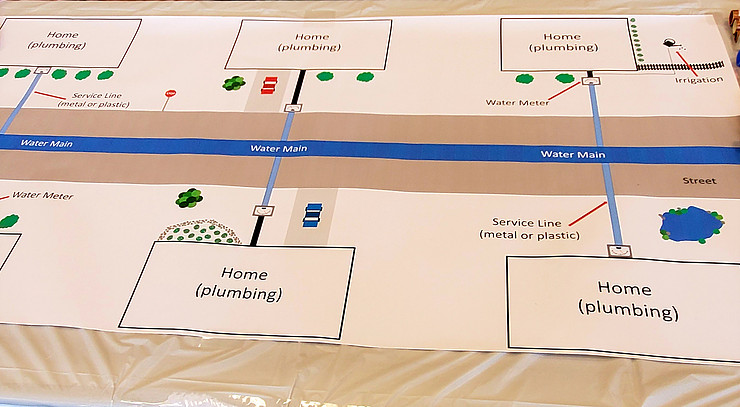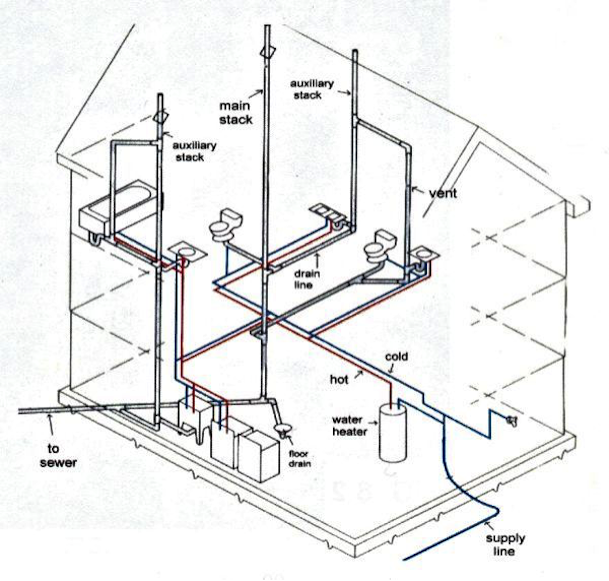The article author is making several good annotation related to Plumbing Installation 101: All You Need to Know as a whole in this article down below.

Understanding exactly how your home's plumbing system functions is important for every single homeowner. From providing tidy water for alcohol consumption, cooking, and bathing to securely getting rid of wastewater, a well-maintained plumbing system is vital for your family's wellness and comfort. In this detailed guide, we'll check out the intricate network that comprises your home's pipes and offer ideas on maintenance, upgrades, and handling typical issues.
Introduction
Your home's pipes system is more than just a network of pipelines; it's an intricate system that ensures you have access to tidy water and efficient wastewater removal. Recognizing its components and exactly how they interact can help you stop expensive fixings and guarantee whatever runs efficiently.
Fundamental Components of a Plumbing System
Pipes and Tubing
At the heart of your plumbing system are the pipes and tubing that bring water throughout your home. These can be made from numerous products such as copper, PVC, or PEX, each with its benefits in regards to durability and cost-effectiveness.
Fixtures: Sinks, Toilets, Showers, etc.
Fixtures like sinks, toilets, showers, and tubs are where water is utilized in your house. Recognizing just how these components attach to the pipes system assists in identifying issues and preparing upgrades.
Shutoffs and Shut-off Points
Valves manage the flow of water in your pipes system. Shut-off shutoffs are vital throughout emergency situations or when you need to make repair work, enabling you to isolate parts of the system without disrupting water flow to the entire residence.
Water System
Key Water Line
The primary water line connects your home to the community water supply or an exclusive well. It's where water enters your home and is dispersed to different components.
Water Meter and Stress Regulator
The water meter steps your water usage, while a stress regulatory authority makes sure that water streams at a safe pressure throughout your home's pipes system, stopping damage to pipelines and components.
Cold Water vs. Hot Water Lines
Recognizing the difference in between cold water lines, which supply water directly from the major, and warm water lines, which bring heated water from the hot water heater, assists in fixing and planning for upgrades.
Water drainage System
Drain Pipes Pipeline and Traps
Drain pipes lug wastewater away from sinks, showers, and bathrooms to the drain or septic system. Traps prevent sewage system gases from entering your home and likewise trap particles that might cause obstructions.
Ventilation Pipes
Air flow pipes permit air right into the drainage system, protecting against suction that can slow down drain and cause catches to empty. Proper air flow is important for maintaining the stability of your pipes system.
Value of Proper Water Drainage
Guaranteeing correct drain prevents back-ups and water damages. Routinely cleansing drains and keeping traps can protect against expensive repairs and prolong the life of your plumbing system.
Water Heater
Sorts Of Hot Water Heater
Water heaters can be tankless or typical tank-style. Tankless heating units warm water on demand, while containers keep warmed water for immediate use.
Updating Your Plumbing System
Reasons for Updating
Upgrading to water-efficient fixtures or changing old pipes can improve water top quality, reduce water expenses, and increase the worth of your home.
Modern Plumbing Technologies and Their Advantages
Explore modern technologies like wise leak detectors, water-saving commodes, and energy-efficient water heaters that can conserve money and lower environmental influence.
Expense Considerations and ROI
Determine the upfront expenses versus long-term financial savings when considering plumbing upgrades. Several upgrades pay for themselves via decreased energy expenses and less repair work.
Exactly How Water Heaters Attach to the Plumbing System
Understanding just how water heaters attach to both the cold water supply and hot water circulation lines helps in identifying concerns like insufficient warm water or leaks.
Maintenance Tips for Water Heaters
Consistently flushing your hot water heater to remove sediment, inspecting the temperature level settings, and checking for leakages can extend its life expectancy and boost energy effectiveness.
Usual Plumbing Problems
Leakages and Their Causes
Leaks can take place as a result of aging pipelines, loose installations, or high water stress. Dealing with leakages promptly avoids water damages and mold and mildew growth.
Blockages and Obstructions
Obstructions in drains and toilets are commonly brought on by flushing non-flushable items or an accumulation of oil and hair. Making use of drain screens and bearing in mind what decreases your drains pipes can protect against obstructions.
Signs of Plumbing Issues to Look For
Low water pressure, slow drains, foul odors, or uncommonly high water costs are indicators of potential pipes problems that should be dealt with quickly.
Plumbing Upkeep Tips
Regular Evaluations and Checks
Schedule annual plumbing inspections to catch issues early. Search for indicators of leakages, deterioration, or mineral build-up in taps and showerheads.
DIY Maintenance Tasks
Straightforward tasks like cleaning tap aerators, looking for bathroom leaks using color tablets, or protecting exposed pipelines in chilly climates can protect against significant plumbing issues.
When to Call a Professional Plumbing Technician
Know when a plumbing concern needs expert know-how. Attempting intricate repair services without proper understanding can lead to even more damage and higher fixing costs.
Tips for Reducing Water Usage
Easy behaviors like taking care of leaks promptly, taking much shorter showers, and running full lots of laundry and dishes can preserve water and reduced your utility bills.
Eco-Friendly Pipes Options
Consider sustainable pipes materials like bamboo for floor covering, which is durable and eco-friendly, or recycled glass for counter tops.
Emergency situation Preparedness
Actions to Take Throughout a Plumbing Emergency situation
Know where your shut-off shutoffs are located and just how to switch off the water in case of a burst pipeline or major leakage.
Relevance of Having Emergency Get In Touches With Convenient
Keep get in touch with info for neighborhood plumbing professionals or emergency services easily offered for fast reaction throughout a pipes crisis.
Environmental Influence and Conservation
Water-Saving Fixtures and Home Appliances
Setting up low-flow taps, showerheads, and commodes can significantly decrease water usage without compromising efficiency.
Do It Yourself Emergency Situation Fixes (When Suitable).
Short-lived solutions like making use of duct tape to patch a leaking pipe or positioning a pail under a dripping faucet can reduce damage up until a specialist plumbing professional arrives.
Final thought.
Recognizing the makeup of your home's pipes system encourages you to maintain it efficiently, conserving money and time on fixings. By adhering to routine upkeep regimens and remaining notified regarding contemporary pipes innovations, you can guarantee your pipes system operates effectively for years to find.
Understanding Your Home Plumbing System: A Comprehensive Guide
Plumbing System: The Lifeline of Your Home
At its core, the plumbing system is designed to perform two primary functions: bring fresh water into your home and remove wastewater. The system is a network of pipes, fixtures, and other components that transport water and sewage. Residential plumbing systems include potable water supply lines, drain-waste-vent (DWV) systems, and various plumbing fixtures that make water use in daily tasks possible.
Key Components:
Water Supply: This part of your plumbing system brings municipal water into your home, passing through the main water supply line. It s responsible for supplying all water needs, from drinking to bathing.
Drainage System: It carries waste and water away from your home to the sewer or septic system. This system includes all the piping within your home that leads to external sewage or septic systems.
Vent System: An essential yet often overlooked component, the vent system allows sewer gases to escape and lets air into the drainpipes, ensuring water and waste move correctly through the system.
Fixture: More Than Just Taps and Toilets
Plumbing fixtures are the most interactive parts of the plumbing system, including faucets, showers, toilets, and sinks. Each fixture is connected to the plumbing system and plays a role in either the delivery of freshwater or the disposal of waste and wastewater.
Types of Fixtures:
Faucets and Sinks: Used for washing hands, dishes, and other daily water needs. Toilets: Dispose of human waste through the sewage system. Bathtubs and Showers: Provide bathing facilities, requiring both hot and cold water supply. Water Supply: The Source of Life
The water supply system is a critical component, ensuring that potable water is available throughout your home for various uses, including drinking, cooking, and cleaning. This system consists of pipes that distribute water to different parts of the house, controlled by valves to regulate the water flow.
Types of Plumbing: Materials and Methods
Various types of plumbing systems and materials are used in residential settings, each with its advantages and applications. From copper and PVC pipes for water supply to cast iron and ABS for drainage, the choice of materials can impact the longevity and efficiency of your plumbing system.
https://intownplumbingtx.com/articles/home-plumbing-system-guide/

I am very involved in Understanding Your Home's Plumbing Anatomy and I hope you enjoyed reading my article. Are you aware of another person who is occupied with the subject? Be sure share it. Many thanks for going through it.
Book Services